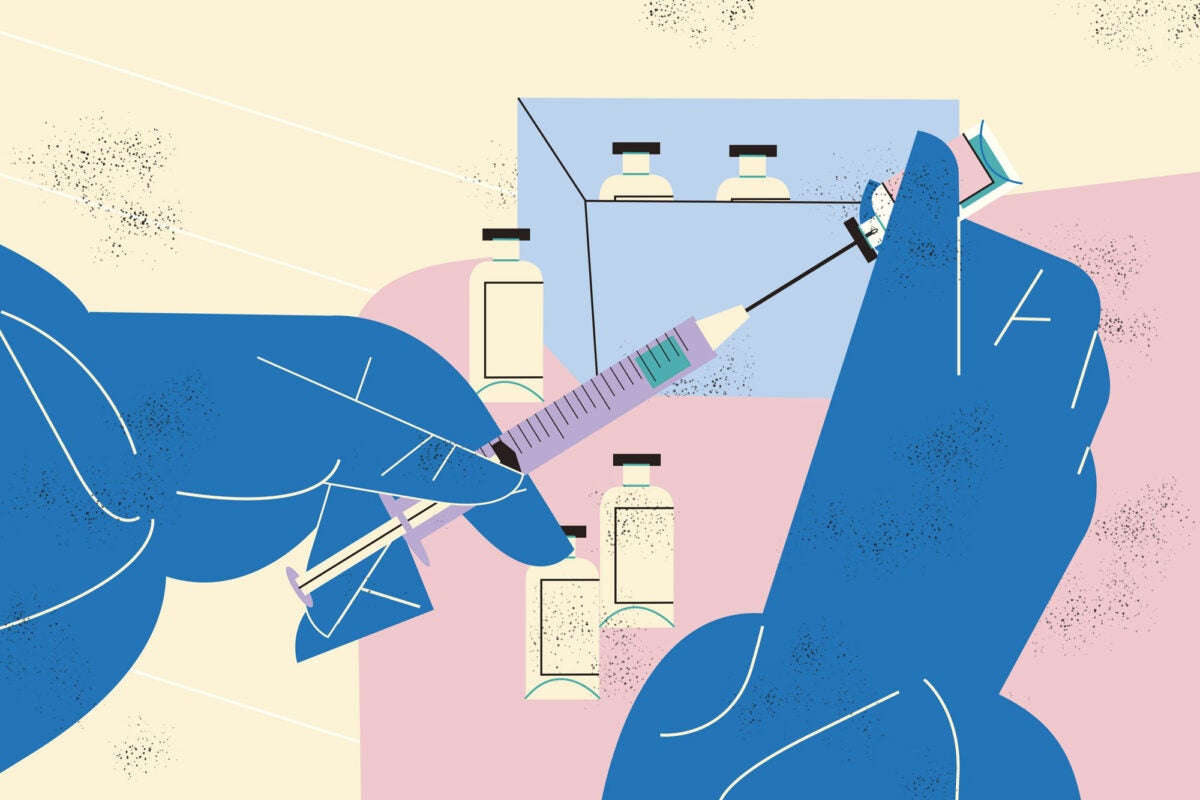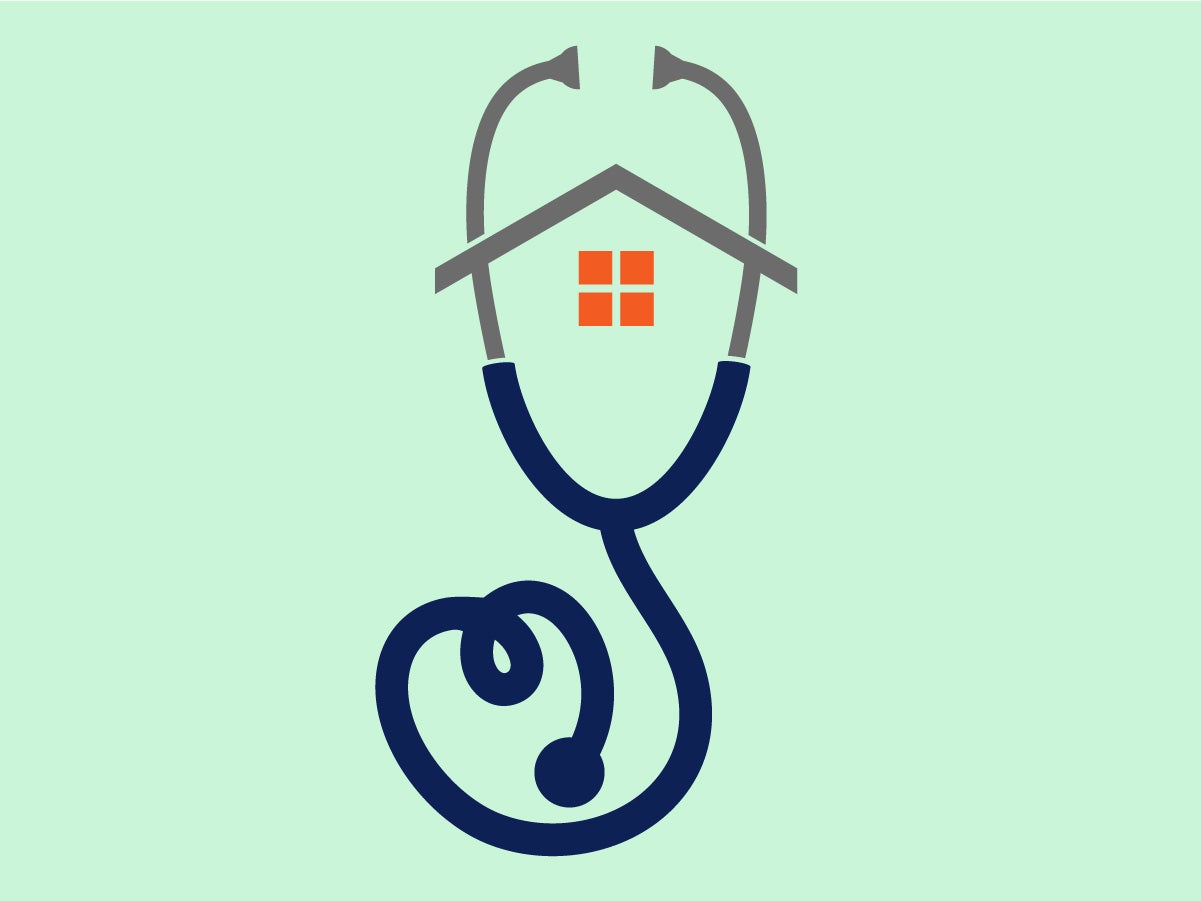
Opinion
Vaccines: a victory and a failure
This story was originally published by Public Health Watch.
On Sept. 23, as I was helping my daughter move into her dorm at the University of California, Santa Barbara, I tested positive for COVID-19. I was feeling a little tired and foggy, but not terrible. I only tested because my husband, who had sniffles and a sore throat, texted news of his positive result. That morning, we had gone to two pharmacies in search of COVID-19 booster vaccines. We couldn’t find them, and now it was too late.
Sign up for Harvard Public Health
Delivered to your inbox weekly.
New COVID-19 boosters were recommended by the Centers for Disease Control and Prevention in mid-September. These vaccines target the highly transmissible XBB.1.5 strain, a subvariant of omicron, and are expected to be effective against most COVID-19 viruses currently circulating in the U.S. The vaccine is recommended for everyone six months and older, regardless of prior vaccination history.
At the same time, flu vaccine campaigns are under way across the country. Nearly everyone over six months old should get one. Even egg-allergic patients can now be safely vaccinated with any flu vaccine. I plan to get my flu shot as soon as I’m fully recovered from COVID-19.
In a major victory for modern medicine, we also have our first vaccines to prevent respiratory syncytial virus (RSV). RSV can cause the common cold, but also bronchiolitis (swelling of the small airway passages in the lungs) and pneumonia. Young children and older adults are at higher risk for poor outcomes.
A maternal RSV vaccine and new pediatric antibody product will help lower the risk of RSV in infants. Adults 60 and older also are eligible for the shots. RSV leads to an estimated 60,000-160,000 hospitalizations and 6,000-10,000 deaths among adults 65 years of age and older each year. The vaccine for older adults is more than 80 percent effective at preventing lower respiratory tract infection in the first season after administration.
We should be celebrating—and rushing to pharmacies and clinics for our shots. But if trends follow what we saw with the last set of COVID boosters—and what we see every year with flu shots—more than half of American adults will skip this potentially life-saving activity. It leaves me, and many of my physician colleagues, feeling frustrated and incredulous.
Vaccines work
A preponderance of evidence proves that these vaccines save lives. The CDC estimates that flu shots prevent 20,000 to 60,000 deaths each year in the U.S. COVID-19 booster vaccines have the potential to be even more impactful, depending on the severity of outbreaks this fall and winter. Both vaccines are safe, and they effectively reduce illness severity, even in those with breakthrough infections. Adult RSV vaccines will likely gain traction with time and are expected to save even more lives.
When I first heard about the availability of the original COVID vaccines in December 2020, at the end of that horrible year when the world shut down, I burst into happy tears. At last, an end was in sight. My husband, a hospital-based pediatrician, was among the first vaccinated. Other physician friends and I shared photos of ourselves getting “the jab,” all of us rejoicing that we no longer had to live in fear.
Most doctors embraced these early COVID-19 vaccines. According to a survey by the American Medical Association, over 96 percent of physicians were fully vaccinated against COVID-19 in the first six months after the shots became available. Coverage rates for influenza aren’t quite as high, but still usually exceed 90 percent among physicians—nearly double the rates seen in the general population.
Admittedly, the vaccines aren’t perfect. Our hopes, in those first weeks and months of COVID-19 vaccine availability, proved unrealistic. We found that vaccine efficacy wanes with time. And the virus mutates, becoming more resistant to vaccines. With influenza as well, vaccines are usually only about 40 to 60 percent effective at preventing illness.
But in the ways that matter most—the ability to prevent hospitalization and death, and to lower the risk of long COVID—COVID-19 vaccines have been a success. The Commonwealth Fund estimated that COVID-19 vaccines resulted in 18.5 million fewer hospitalizations and prevented 3.2 million additional deaths in the first two years after the shots became available. Flu vaccines, too, prevent thousands of deaths and tens of thousands of hospitalizations each year. RSV vaccines are yet another life-saving shield.
Vaccines aren’t popular
With flu vaccines, the numbers are bad enough: Just under 50 percent of adults and about 58 percent of kids receive the seasonal shot every year.
But with COVID-19 booster vaccines, the situation is worse. According to the CDC’s most recent update in May, while 81.4 percent of the population received at least one COVID-19 vaccine, only 21 percent of U.S. adults—and even fewer children—got the updated bivalent COVID-19 booster released in August 2022.
Despite solid data showing COVID-19 vaccines are safe and effective, and despite over 19,000 weekly COVID-related hospitalizations throughout September, some people will intentionally avoid vaccines this fall while others will just not get around to it. They claim they don’t need them. They recite a long list of untruths about the vaccines, repeating what they’ve seen on Facebook or YouTube or heard from irresponsible doctors.
Among those swept up in the rising COVID-19 hospitalizations since mid-July, most were unvaccinated or had not received the last booster shot. Still, in recent surveys, only about 40 to 46 percent of adults said they would definitely or probably get the updated COVID-19 vaccine.
Only 21 percent of U.S. adults—and even fewer children—got the updated bivalent COVID-19 booster released in August 2022.
The medical community and public health leaders have failed to instill confidence in vaccines. Our communications have been confusing. Access to COVID-19 vaccines, at least initially, was inequitable. We set expectations too high with the first round of COVID-19 shots, hoping that one-and-done would be enough, not realizing that vaccine manufacturers would be left chasing a mutating virus that was learning to evade our new tools.
Social media has worsened the situation, with terrifying, often false, stories of vaccine mishaps and nightmare scenarios. Political divisions have contributed to mistrust, leading to vaccine hesitancy and refusal. Even some doctors have become skeptical of institutions we once revered.
Awareness and availability of the new vaccines—COVID-19 boosters and RSV—are also problems. My daughter and I weren’t the only ones who failed to find a pharmacy for our COVID-19 boosters. Jennifer Hamilton, a fellow family physician in Philadelphia, told me she’s seeing lots of problems with availability. Her own husband, Phil Salkie, encountered outdated websites, unstocked pharmacies, misinformed pharmacists, and insurance obstacles during his “wasted afternoon” seeking COVID-19 and RSV shots. My mother, in Austin, found flu and RSV vaccines but not COVID-19. Such barriers are likely to contribute to even lower vaccination rates. Our institutions and communities need to be better prepared.
Rebuilding trust will take time, creativity, and tenacity. As I start a new job working with people with multiple sclerosis, I am preparing for the questions and doubts I’ll face from my patients. Other physicians around the country are doing the same.
We trust doctors to diagnose and treat cancer and chronic disease, perform complex surgeries, and guide us through all stages of life. We trust pharmaceuticals to treat symptoms and illnesses: ibuprofen for headaches, antibiotics for strep throat, atorvastatin for high cholesterol. But the demonizing of vaccines—one of our most impactful, cost-effective public health tools—continues to create needless suffering and loss of life.
What can you do?
When fewer people are vaccinated, rates of infection will be higher. That makes personal vaccination even more important. Here are my recommended individual actions, barring contraindications:
- Get a flu vaccine, if you haven’t already. Usually September or October are the best months for flu shots.
- Get the new COVID-19 booster. Call ahead to make sure your pharmacy has the vaccine in stock. For most of us, only one dose is recommended, unless you are moderately or severely immunocompromised. If, like me, you’ve had COVID-19 recently, you can wait at least three months.
- Remember that both flu and COVID-19 vaccines take about two weeks to be effective.
- If you’re over 60, strongly consider the RSV vaccine. Weigh the potential risks and benefits with your healthcare provider, given your age and underlying conditions.
- Vaccines can be given at the same time, though common side effects, like injection-site soreness and fever, may occur more often with coadministration. Some studies indicate that the immune response may not be quite as strong when RSV and influenza vaccines are given together, but this finding may not be clinically significant.
- Be attentive to other preventative activities: avoid close contact with others who are sick and stay home if you’re not well, consider masking in crowded public places, wash hands often.
- If you do get sick, get tested for flu and COVID-19, and talk to your healthcare provider about antiviral treatment options, especially if you have other medical conditions.
Top image: Antonio Rodrigues / Adobe Stock


